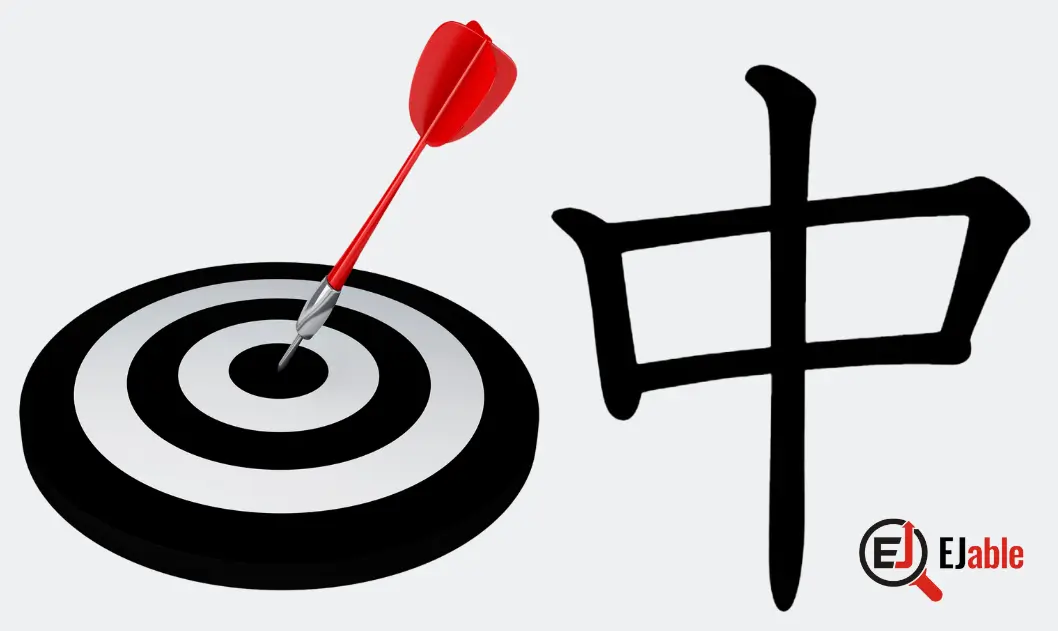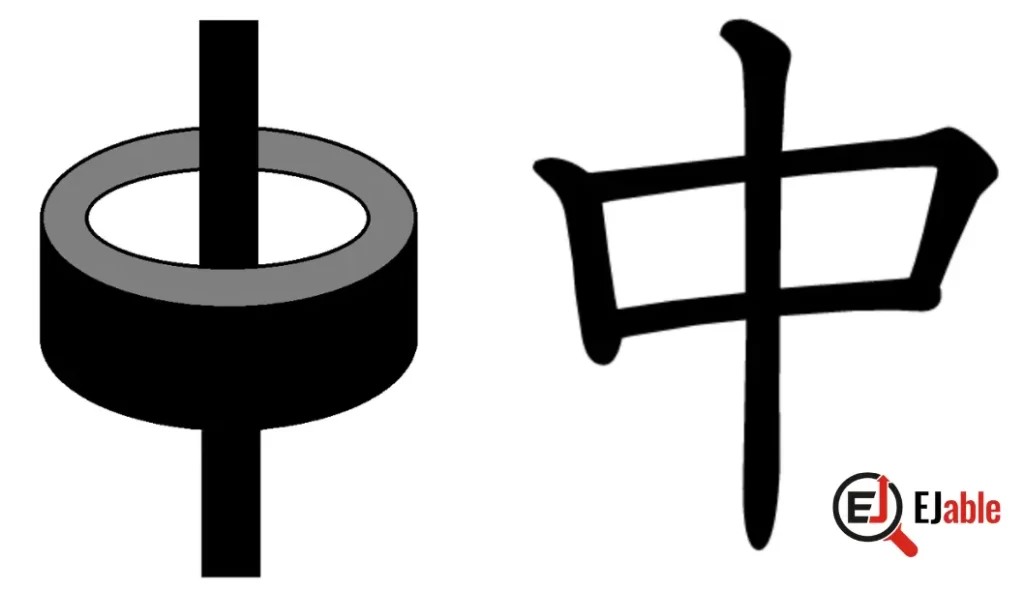Kanji for “Middle,” “Inside,” “Within”: 中 (Naka, Chu)

The Japanese Kanji meaning “Inside,” “Middle,” or “Within” is 中. The Kun’yomi, or the Japanese pronunciation of the Kanji 中, is “naka” (なか), and the On’yomi (Chinese) pronunciation is “ju” (ジュウ) or “chu” (チュウ).
The Kanji 中, meaning middle, is part of JLPT N5 (please check the list of JLPT N5 Kanji) and is taught in grade 2 in Japanese schools.
Construction and Origin of the Shape 中
This Kanji for “middle” with 4 strokes is one of the simplest Kanji characters to remember, even though its origin is debatable.
Some people believe that the Kanji 中 for Middle, Inside, or Within originated as a pictogram representing an arrow hitting the center of a target. This pictorial representation captures the essence of being in the middle or at the center.
However, the exact origins of many ancient Kanji characters, including 中, can be challenging to pinpoint precisely due to the written language’s long history and evolution. While the depiction of an arrow hitting a target is a commonly cited interpretation for 中, it’s important to consider that this explanation might be more of a mnemonic or a later rationalization rather than a historically accurate representation of its earliest form.
The origins of Kanji lie in ancient Chinese Kanji characters, which evolved over thousands of years. These characters often started as simple pictograms or ideograms representing concrete objects or ideas. Over time, they became more stylized and abstract.
It’s entirely plausible that the original concept for 中 might have predated the invention of the bow and arrow or represented a different central or middle concept in its earliest forms. The interpretation of ancient characters often involves a bit of speculation and inference, especially considering the vast expanse of time over which these characters developed and evolved.
So, considering the above logic, let’s try to create some mnemonics to learn the Kanji for Middle, Inside, or Within.
Mnemonic: How to Remember the Kanji for Middle or Inside (中)
While the debatable origin, as depicted in the illustration at the top of this article, can very well serve as a mnemonic to remember the Kanji 中 meaning “Inside,” “Middle,” or “Within”, the following illustration may serve this purpose better:

Explanation
The above illustration shows a hollow cylinder with a vertical line passing through it in the middle.
The front view, as described in the guide to learn and remember Kanji, depicts this as the Kanji we are discussing to show that there is something in the middle or within it.
This illustration shows that something is passing through the middle of the hollow cylinder but is not confined inside.
Other Meanings of Kanji 中
Centrality
Besides its primary meaning of “middle” or “center,” 中 is used to denote centrality in various contexts, like “inside,” “among,” or “during.”
Following are examples of the use of 中 in the context of defining Centrality and Middleness:
- Tokyo Tower wa Tōkyō no chūshin ni arimasu. (東京タワーは東京の中心にあります。)
- “Tokyo Tower is located in the center of Tokyo.”
- David wa denwa-chūdesu. (デビッドは電話中です。)
- “David is on a phone call.”
- Debiddo wa kaigi-chūdesu. (デビッドは会議中です。)
- “David is in a meeting.”
- Kare wa kaigi de chūkan taido o torimashita. (
- “He took a middle stance in the meeting.”
Core or Essential Part
The Kanji 中 can also refer to the core or essential part of something. Following are some examples of such usages:
- Kono mondai no nakami wa fukuzatsu desu. (この問題の中身は複雑です。)
- “The content of this issue is complex.”
- Kanojo no hanashi no naka ni taisetsu na pointo ga kakurete imasu. (彼女の話の中に重要なポイントが隠れています。)
- “An important point is hidden within her story.”
Medium or Intermediate:
In certain contexts, 中 can imply something that is medium in size or degree or something intermediate. Please check the following examples:
- Kono saizu wa chūsaizu desu. (このサイズは中サイズです。)
- “This size is a medium size.”
- Kare wa nihongo no chūkyūsha desu. (彼は日本語の中級者です。)
- “He is an intermediate-level Japanese language learner.”
These sentences cover various uses of 中 in everyday Japanese, illustrating its versatility in representing central locations, core elements of a subject, and intermediate or medium states or positions.
中 as a Component in other Kanji Characters
Please note that the Kanji 中 (chū/naka) for “middle” is not used as a radical. There is another radical 虫 that people often confuse with the radical for the Kanji 中. However, please note that the Kanji 虫 represents “bug” and is different. The interesting point is that the Kanji for bug 虫, uses the Kanji for middle as a component.
However, Kanji 中 appears as a component in 534 Kanji characters, including 34 Jōyō Kanji. When it appears as a component, it often imparts meanings related to being central, inside, or in the middle.
Examples of Inside’s Kanji 中 as a Component
The following are examples of Kanji characters that use 中 as a component:
- 虫 (むし / mushi): Insect.
- 強 (つよい / Tsuyo–i): Strong
- 使 (つかう / Tsuka-u): To use
- 風 (かぜ / Kaze): Wind
- 靴 (くつ / Kutsu): Shoes
- 史 (シ / Shi): History
- 仲 (なか / Naka): Good friend, go-between
- 革 (かわ / Kawa): Leather
- 触 (さわる / Sawa-ru, ふれる / Fu-reru): Touch
- 独 (ひとり / Hito-ri): Alone
- 忠 (チュウ / Chū): Loyal
- 沖 (おき / Oki): Offshore; Open sea, Offing
- 吏 (リ / ri): Official
These examples more accurately represent the use of 中 as a component, often found in Kanji related to insects or concepts that metaphorically relate to the idea of something central or intrinsic.
Middle or Inside Kanji in Compounded Words
The Kanji for Middle or Inside commonly appears in many compounded Kanji characters. There are 670 Japanese words that begin with the Kanji 中, and it appears in 1234 words.
Examples of Kanji 中 in Compounded Kanji Characters
Following are the examples where Kanji for Inside or middle appears in Japanese compounded Kanji characters:
- 中心 (ちゅうしん / chūshin): Center, core.
- 中央 (ちゅうおう / chūō): Central, middle.
- 中間 (ちゅうかん / chūkan): Middle, midway.
- 中止 (ちゅうし / chūshi): Suspension, interruption.
- 中学 (ちゅうがく / chūgaku): Middle school.
- 中古 (ちゅうこ / chūko): Secondhand, used.
- 中国 (ちゅうごく / Chūgoku): China, and also a region in Japan.
- 中身 (なかみ / nakami): Contents, inside.
- 中途 (ちゅうと / chūto): Midway, in the middle.
- 中継 (ちゅうけい / chūkei): Relay, broadcasting.
- 午前中 (ごぜんちゅう / gozenchū): In the morning.
- 中毒 (ちゅうどく / chūdoku): Poisoning, addiction.
- 中立 (ちゅうりつ / chūritsu): Neutrality.
- 中年 (ちゅうねん / chūnen): Middle-aged.
- 中指 (なかゆび / nakayubi): Middle finger.
These compound words demonstrate the versatility of 中 in various contexts, illustrating its use in physical, temporal, and abstract terms related to the concept of middle or center.
Check other Kanji characters on the page “How to Remember Kanji“. You may also like to read about the common Kanji radicals.

A long-term ex-pat in Japan, Himanshu comes with an IT background in SAP consulting, IT Business Development, and then running the country operations of an IT consulting multinational. Himanshu is the co-founder and Managing Director of ReachExt K.K. and EJable.com. He is also an Advisory Board Member of a Silicon Valley AI/IoT startup.
